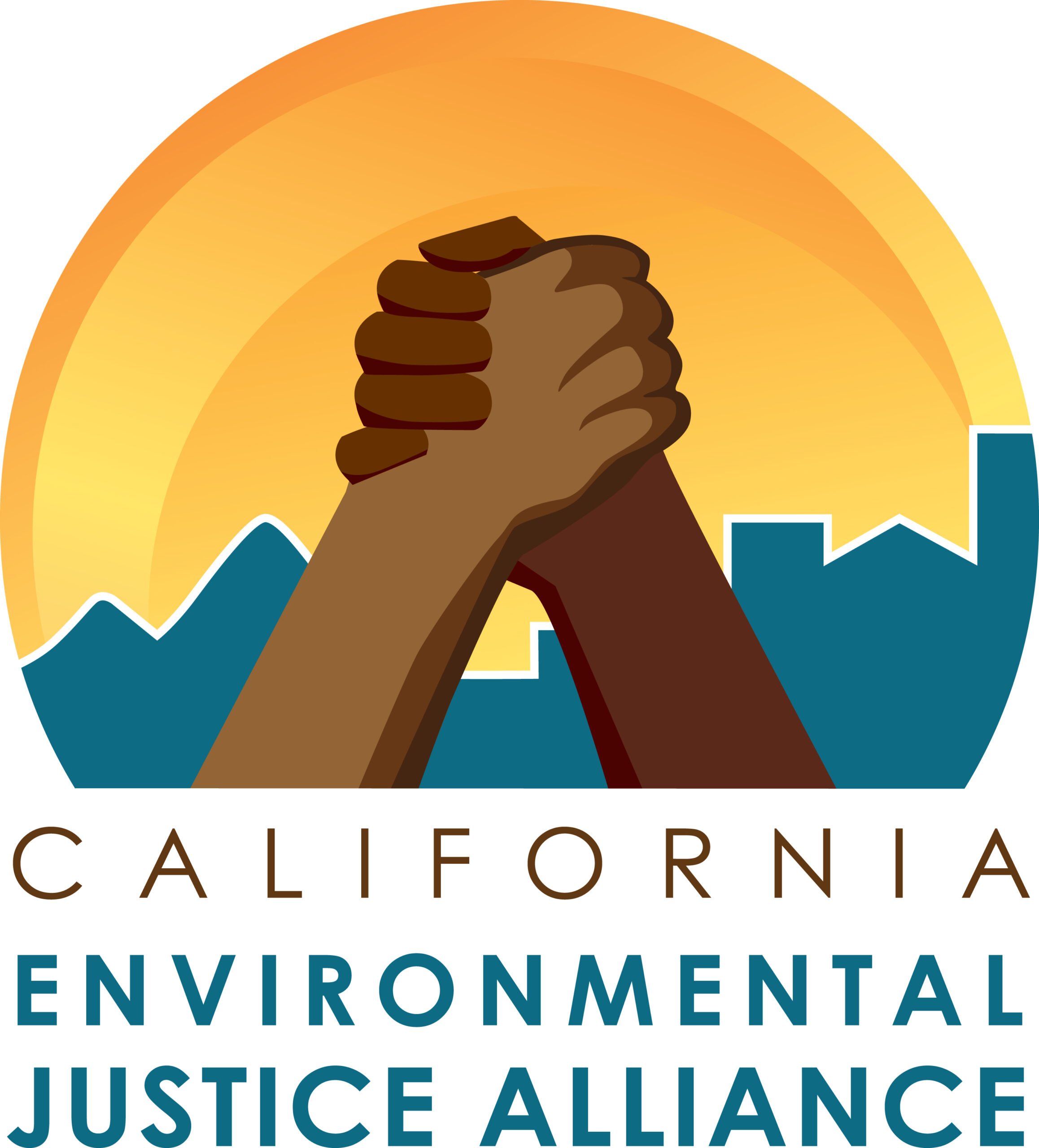Environmental Justice Equity Principles for Green Hydrogen in California
We represent heavily polluted communities throughout the State of California. Our communities border oil refineries, gas-fired power plants, industrial farming operations, fossil fuel extraction facilities, waste processing centers, ports, transportation corridors, and other polluting operations. These cumulative sources of pollution cause a wide range of adverse health outcomes in working class communities of color. Our communities share a common fence with facilities and operations that emit toxins, foul smells, and noise and cause nuisance, impacting people’s quality of life at all hours of the day and night.
The State of California intends to expand the use of hydrogen as a fuel, and to this end, we offer these guiding principles, which are essential to respect and protect our communities. The following principles represent our collective values and positions to support communities as hydrogen energy is utilized across the state.
These principles were developed in ten workshops and learning sessions for environmental justice partners across California between March and September of 2023. The learning sessions examined the current science, including risks, benefits, and unknowns, and shed light on each stage of the hydrogen cycle, including production, delivery, storage, and use. The workshops allowed our organizations to discuss different perspectives, build consensus, and reflect on how hydrogen may impact our communities.
We adamantly oppose all non-green hydrogen proposals and projects. We insist that new projects protect communities first and do not perpetuate the injustices that polluting infrastructures impose on fence-line communities today. Each stage of the hydrogen life cycle—production, delivery, storage, and end use—can present unique risks and harms to environmental justice communities and to all Californians. Discussions about building new green hydrogen infrastructure must involve the community, and its members should be meaningfully engaged. Siting green hydrogen infrastructure should also take into account the cumulative impacts of environmental justice communities and the risks associated with hydrogen.
WHO WE ARE
Communities for a Better Environment (CBE)
Environmental Health Coalition (EHC)
Leadership Counsel for Justice and Accountability (LCJA)
Pacoima Beautiful (PB)
Physicians for Social Responsibility Los Angeles (PSR-LA)
Asian Pacific Environmental Network (APEN)
California Environmental Justice Alliance (CEJA)
Center for Community Action and Environmental Justice (CCAEJ)
Center on Race, Poverty & The Environment (CPRE)
Equity Principles for HydrogenProduction
-
a. The hydrogen is made using electrolysis of water
i. Where water used as feedstock is surplus and not diverted from sources which serve
jurisdictions that are struggling or failing to meet clean drinking water needs.b. Electrolysis is powered only by electricity produced from new dedicated wind or solar
power, andi. The facility generating the electricity used for the production of green hydrogen does
not use tradable renewable energy credits.c. If any electrolysis facility is connected to the California electricity grid, it must honor
the hourly use concept:i. The new renewable generation resource provided for in subsection b (i) above has a
first point of interconnection to the California balancing authority in which the
electrolytic hydrogen production facility is sited, andii. The electrolytic hydrogen production facility must use the new renewable electricity in
the same hour that the electricity is delivered to the grid.d. Green hydrogen is not defined according to pounds of CO2 equivalent.
e. We oppose carbon capture in hydrogen production operations.
f. The above conditions must be the starting point for informed community consent to
hydrogen production projects. Though the specifics of a green hydrogen production
project may be undefined at the outset of community engagement, the public should
have faith that all the above conditions are met under any project permutation. -
a. Projects must include EJ protections related to water use for production/desalination.
b. Projects must not negatively impact California’s already stretched water supply.
c. Projects must not use potable water when drinking water needs are not met.
-
a. State agencies must mandate any recipient of Federal or State level funding to
undergo training on Tribal history, cultural sensitivity, and the significance of the
Tribal consultation process for all recipient staff expecting to participate in any
hydrogen or related project. This requires ongoing education to keep staff updated on
evolving Tribal engagement practices. Educational material should be designed by
California Native-led nonprofits or the California Native American Heritage
Commission.b. All public agencies that have the principal responsibility for carrying out, approving,
or expecting to participate in any hydrogen or related project must conduct extensive
outreach to California Native American Tribe(s) to increase their sign-on to the Tribal
notification list; each agency should have to complete the CEQA process as required
by PRC 21080.3.1(b)(1). This should also include updating any outdated
communication information to assure proper notification for California Native
American Tribe(s) when an agency undertakes a hydrogen or hydrogen related
project.c. When a public agency decides to undertake a hydrogen or related project, or decides
an application for such a project is complete, this agency must begin the AB 52
Tribal Consultation process. A Tribal liaison must be appointed from the agency
with extensive knowledge of the project and Tribal engagement practices to facilitate
communication, answer questions, and address concerns from Tribal representatives.d. If California Native American Tribe(s) request consultation, a good faith and
reasonable effort should be conducted with best practices that include establishing a
formal process for meetings, site visits, and opportunities for collaborative discussions
and allocating sufficient time for meaningful engagement and dialogue, allowing
Tribes to provide input and voice concerns.e. Mandate cultural resource assessments for all projects that may impact Tribal
resources to include Tribal experts in the assessment process to ensure accurate
cultural insights.f. Provide consistent updates to Tribes throughout the project's lifecycle, informing them
of any changes or developments.g. Seek feedback from Tribes on the agency's Tribal consultation process and
continuously work to improve its effectiveness.h. Assure that any changes to a General Plan or adoption/changes to a Specific Plan in
order to create a hydrogen or related project initiates the SB 18 Tribal consultation
process in consultation with the Native American Heritage Commission (NAHC). Same
practices for the AB 52 process should be followed in this procedure as well. -
a. Informed community consent is necessary, and should be sought in addition to
production conditions listed under #1 being met.b. Center community input, continue to elevate EJ voices, and ensure meaningful
community participation is present for any hydrogen project. This includes providing
language access such as interpretation and translation services for non-English
speakers, depending on the common languages spoken in the particular community.c. When a public agency decides to undertake a hydrogen or related project, or decides
an application for such a project is complete, this agency must begin the AB 52 Tribal
Consultation process. A Tribal liaison must be appointed from the agency with
extensive knowledge of the project and Tribal engagement practices to facilitate
communication, answer questions, and address concerns from Tribal representatives. -
a. Hydrogen produced using reformation or gasification is not green hydrogen.
i. This includes hydrogen produced by reformation of municipal solid waste gas,
livestock biogas (factory farm gas), biomass, lignite or coal, andii. Hydrogen produced using any fossil fuel as a feedstock.
b. Hydrogen produced from electrolysis, but powered by dirty electricity sources is not
green hydrogen.i. Dirty electricity sources include but are not limited to:
1. Energy produced from combustion of fossil gas, landfill gas, municipal solid waste
gas, livestock biogas (factory farm gas), biomass, lignite or coal, and Electricity
produced from nuclear fission or fossil, biogas, or landfill gas fuel cells.2. Electricity produced from nuclear fission or fossil, biogas, or landfill gas fuel cells.
c. Hydrogen produced using carbon capture and sequestration in any point in its
production is not green hydrogen.d. For existing hydrogen production, we support phasing out electrolysis powered by
GHG emitting fuels or non-excess wind/solar. -
a. Hydrogen production should be able to reduce current forms of energy production
pollution.
STORAGE & DELIVERY
-
a. Every hydrogen pipeline and storage infrastructure project must be equipped with
effective leak detection technology.b. Any proposed project to transport hydrogen must include a leak detection response
protocol including an alert system to notify residents and workers of potential
exposure, health risks, and a relocation plan until any leak is resolved.i. This program must include language access to all local populations and contact staff
that can support coordination of leak response protocol. -
a. All hydrogen transmission and storage infrastructure projects should be limited in size
and scope and equipped with design features to:i. Avoid perpetuating the impacts of gas infrastructure on environmental justice
communities,ii. Prevent leaks, spills, breaches, and explosions in or near environmental justice
communities, environmentally sensitive areas, pollution burdened communities,
Tribal land, or any residential areas.b. In considering new hydrogen transmission and storage infrastructure, the project
should:i. Obtain prior and informed consent from every community and/or Tribe where
hydrogen transmission infrastructure originate, pass by, or terminate,ii. Define who is responsible for managing infrastructure leaks throughout the lifecycle
of design, implementation, and maintenance.iii. And should consider:
1. Historic harms gas infrastructure has caused in project communities,
2. Safe, reliable, and efficient alternative methods of energy delivery.
c. Local and regional hydrogen distribution pipelines and storage/compressor facilities
should be limited in size and scope to forward these objectives. -
a. Hydrogen should not be transported in existing methane gas systems.
b. Hydrogen should never be blended into existing methane pipelines or storage
containers. -
a. Research into hydrogen pipeline and delivery infrastructure should focus on data gaps
including, but not limited toi. Leakage;
ii. Appropriate safety testing standards for dedicated hydrogen pipelines;
iii. Hydrogen gas impacts on humans, ecosystems, and the climate;
iv. Risks and challenges of different hydrogen storage options such as
1. Storage in liquid state,
2. Low temperature storage,
3. Ammonia
4. Methanol, and
v. Further exploration of data gaps in hydrogen transmission and storage.
-
a. All hydrogen delivery projects should obtain prior and informed consent required for
communities where pipelines or delivery infrastructure are built or hydrogen is
introduced.b. Hydrogen delivery projects should fully consider and respect
i. Historic harms gas infrastructure has caused in project communities,
ii. Community expertise of their experience, and
iii. Safe, reliable, and efficient alternative methods of energy delivery.
-
a. Pipeline infrastructure presents a cost issue for ratepayers, given how expensive it is to
site and build.
END-USES
-
a. Electrification
i. If the end-use can be electrified, green hydrogen should not be used.
ii. Electrification should always be prioritized over the use of green hydrogen, including
the consideration of rapid advancement in electrification technologies.iii. Emerging electrification technologies should be pursued before considering
hydrogen for the end-use.vi. Electrification research and development should be prioritized above hydrogen
research and development.v. Hydrogen should only be considered when there is a technical or practical constraint
to electrification.b. Harmful end-uses
i. Harmful end-uses should be reduced or phased out altogether, such as excessive
fertilizer use, where possible.ii. Using hydrogen to improve a feedstock for an industry that is a harmful industry
shouldn’t justify the continued operation of that industry.iii. Potential end-uses should use the Precautionary Principle to first prove that using
hydrogen in that context isn’t harmful.c. Community voice and environmental impacts
i. The cost of using green hydrogen in any end-use should not disproportionately
impact EJ communities and ratepayers from lower income families.ii. Public funds should be prioritized for advancing electrification over hydrogen.
iii. All life-cycle impacts, including financial impacts and health and environmental impacts, should be transparently considered.
iv. Any end-use should reduce local and regional pollutants.
v. Informed local communities should have veto power over any hydrogen end-use in
their communities.vi. EJ communities should have a governing voice in end-use decision-making.
vii. Environmental and EJ impact review processes must be thorough and should never
be fast-tracked. -
a. Direct electrification with renewable energy is cheaper, safer and more efficient than
producing green hydrogen, and therefore should be prioritized.b. Green hydrogen should be considered only for necessary end-uses that cannot be
supported by electrification or phased out by alternatives.c. Hydrogen gas should not be used in residential and commercial buildings because
direct electrification with renewable energy is safer and more efficient.d. Hydrogen should not be used in transportation methods that can easily be electrified,
including passenger cars, light-duty trucking, main line rail, and drayage trucking.e. Hydrogen should not be combusted in gas-fired generating units to produce electricity.
f. Hydrogen should not be blended into the fossil gas system in pursuit of
decarbonization.h. We may support the use of hydrogen in fuel cells to power niche applications such as
back-up power for Public Safety Power Shutoff (PSPS) events as long as the high-level
principles mentioned above are also followed. -
a. We agree that the principles outlined at the start of this section and elsewhere
throughout the document should determine whether hydrogen should be used in any
of these applications.b. We agree that more research is needed on green hydrogen in fertilizer but oppose
any end-use that is used to greenwash or justify the continued over-application of
fertilizer in rural communities who are forced to live with contaminated drinking water
as a result.









